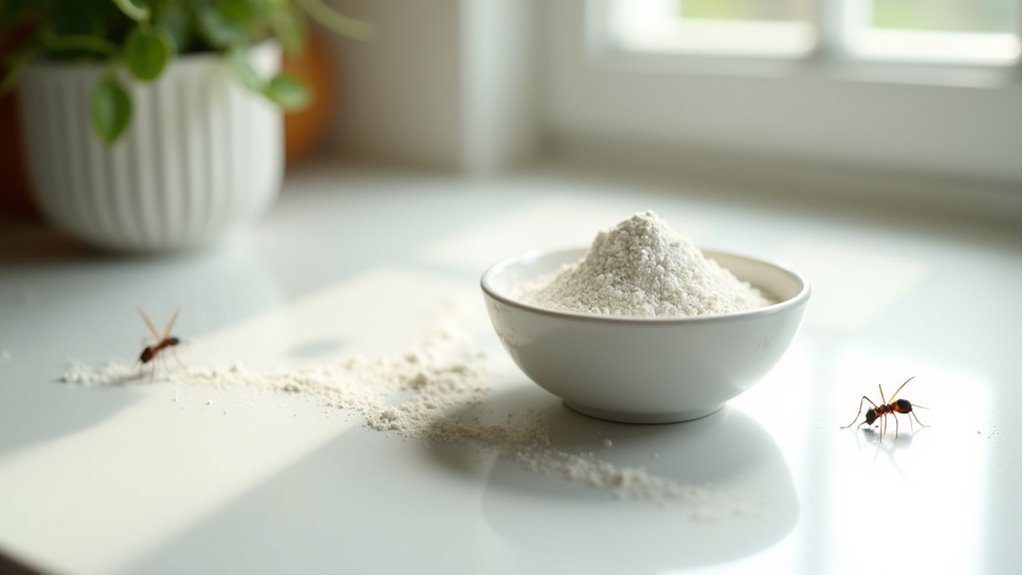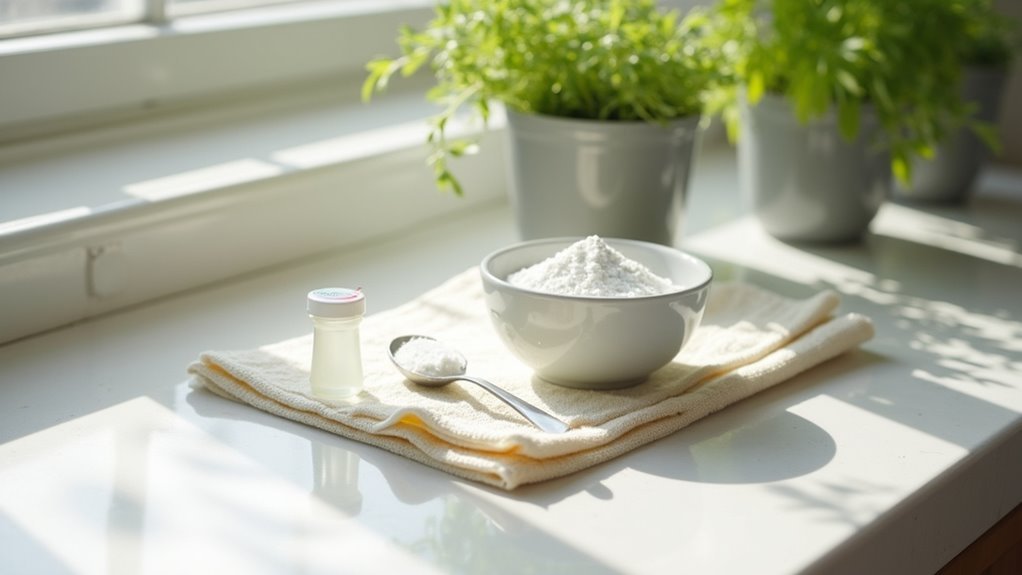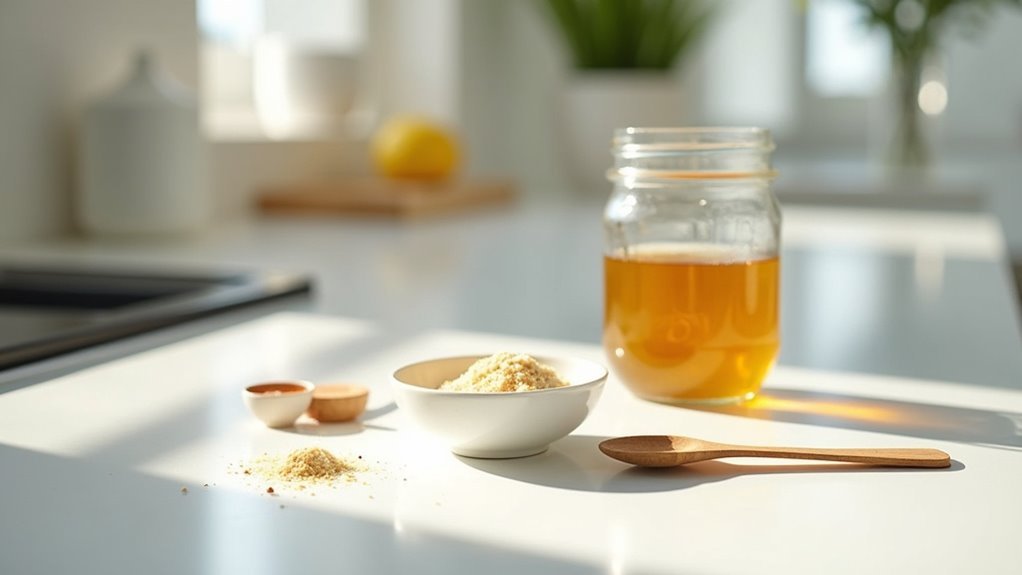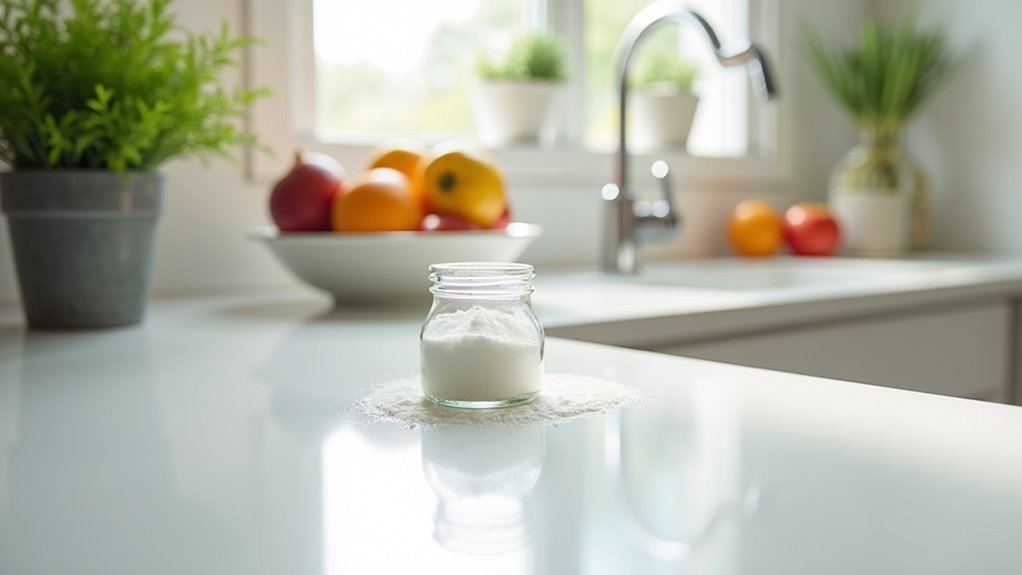You can eliminate kitchen pests safely and effectively using boric acid, which disrupts insect metabolism and creates microscopic cuts that cause dehydration. Mix one part boric acid with three to five parts food attractants like flour, sugar, or peanut butter to create irresistible baits. Place these mixtures in warm, dark areas where pests gather, wearing gloves and masks for protection. This method targets cockroaches, ants, and other crawling insects while remaining safer than commercial pesticides, and understanding proper application techniques will maximize your pest control success.
Understanding Common Kitchen Pests and Their Behaviors

When you’re dealing with kitchen pests, understanding their behaviors becomes essential for effective control.
Cockroaches spread over thirty types of bacteria and trigger allergies, making them your kitchen’s worst nightmare.
You’ll find fruit flies swarming around fermenting fruit after entering through tiny crevices, where they reproduce rapidly in ideal conditions.
Rodents infest millions of homes annually, carrying dangerous diseases like hantavirus and salmonella that threaten your family’s health.
Pantry pests including ants, moths, and beetles contaminate your stored food supplies, spoiling ingredients you’ve invested in.
Effective pest management requires immediate action since prompt removal prevents further infestations.
Understanding these behaviors helps you choose appropriate control methods and target specific kitchen pests more successfully.
Why Boric Acid Is Effective Against Kitchen Invaders
Although many commercial pesticides contain harsh chemicals that pose risks to your family, boric acid offers a powerful yet safer solution for eliminating kitchen invaders. This effective pest control works through multiple mechanisms that make it lethal to household pests like cockroaches.
Boric acid delivers powerful pest elimination without exposing your family to the dangerous chemicals found in traditional pesticides.
When ingested, boric acid disrupts their metabolism, causing them to starve gradually. The microscopic crystals also create tiny cuts on insect exoskeletons, leading to fatal dehydration.
What makes boric acid particularly effective is its ability to spread throughout pest colonies. Contaminated cockroaches carry the toxicant back to their nests through grooming behaviors and cannibalism, poisoning other members.
Since boric acid safe formulations remain active for months, you’ll enjoy long-lasting protection while minimizing exposure to dangerous synthetic chemicals.
Essential Safety Precautions Before Application

Before you apply boric acid in your kitchen, you’ll need to prioritize safety to protect yourself and your family.
You must wear protective gear like gloves and a mask to prevent skin irritation and breathing problems during application.
Additionally, you’ll want to take special precautions to keep children and pets safe from accidental exposure to this pest control solution.
Protective Gear Requirements
Safety gear serves as your first line of defense when handling boric acid solutions for pest control.
Essential protective gear includes gloves and a mask to prevent skin contact and inhalation of harmful dust particles. You’ll need chemical-resistant gloves to protect your hands from irritation during mixing and application. A dust mask prevents respiratory irritation from airborne boric acid particles.
Don’t forget protective eyewear to shield against accidental splashes or dust. Wear long-sleeved clothing to minimize skin exposure throughout the process.
These safety guidelines aren’t optional—they’re vital for preventing health risks. After completing your pest control application, wash your hands thoroughly and properly dispose of all used protective equipment to maintain a safe kitchen environment.
Child and Pet Safety
When children and pets share your living space, protecting them from boric acid exposure becomes your top priority during pest control applications.
Despite its low toxicity compared to commercial pesticides, boric acid still poses risks if ingested or inhaled by vulnerable family members.
Store the product in its original, clearly labeled container placed high beyond reach.
During boric acid application, restrict access to treatment areas until you’ve completed thorough cleanup.
Focus placement exclusively in cracks, crevices, and tamper-resistant bait stations where curious hands and paws can’t reach.
Never apply loose powder in open areas where children crawl or pets walk.
After treatment, vacuum any visible residue and wash surfaces with damp cloths.
Maintaining strict child and pet safety protocols guarantees effective pest control without compromising your family’s wellbeing.
Selecting the Right Grade and Type of Boric Acid
You’ll need to choose the appropriate grade of boric acid for your specific pest control needs in the kitchen.
Technical grade boric acid offers the most cost-effective solution for pest management without requiring higher purity levels that increase costs unnecessarily.
Consider sodium compound variations like sodium tetraborate decahydrate or pentahydrate, as each provides distinct advantages for different application methods.
Technical Grade Selection
Several grades of boric acid exist on the market, but technical grade boric acid stands out as the best choice for kitchen pest control applications.
You don’t need higher purity grades for effective household pests elimination—technical grade delivers proven results against cockroaches without unnecessary costs.
When purchasing technical grade boric acid, you’ll want to buy from reputable sources to guarantee quality and effectiveness.
This grade works as a slow, persistent killer that’s particularly effective against roach populations that’ve developed resistance to other insecticides.
Technical grade boric acid’s dual action makes it invaluable for pest control.
It causes metabolic disruption while creating physical abrasion, giving you multiple modes of attack against resilient kitchen pests in your targeted control strategy.
Sodium Compound Options
Beyond standard technical grade boric acid, sodium-based compounds offer alternative approaches for extensive kitchen pest management.
Sodium tetraborate decahydrate (borax) stands out with its low acute toxicity compared to synthetic insecticides, making it safer for household use. You’ll find it particularly effective against cockroaches while maintaining peace of mind around family and pets.
Sodium tetraborate pentahydrate provides another excellent option, targeting various pests with minimal toxicity in small amounts.
For thorough protection, disodium octaborate tetrahydrate functions as both an insecticide and wood preservative, addressing wood-destroying pests around kitchen cabinets and structures.
These sodium compounds deliver the same pest-fighting power as traditional boric acid powder while offering enhanced safety profiles and specialized applications for your specific kitchen pest challenges.
Creating Homemade Boric Acid Bait Recipes

When creating effective homemade boric acid bait, you’ll need to strike the right balance between attraction and lethality by mixing one part boric acid with three to five parts of appealing food sources.
The classic sweet & starchy dough recipe combines 1/4 cup boric acid powder with 1/2 cup flour and 1/4 cup powdered sugar. Form small balls that’ll attract cockroaches seeking carbohydrates.
Sweet and starchy ingredients create the perfect cockroach bait when combined with boric acid in this proven recipe.
For protein-loving pests, try these variations:
- Mix 1 tablespoon boric acid with 3 tablespoons peanut butter and bacon grease
- Combine boric acid with crushed pet food for enhanced appeal
- Add moisture to create sticky, irresistible textures
Place baits in warm, dark areas under appliances and inside cabinet corners near water sources.
Replace them regularly over several weeks to effectively manage pests and eliminate entire populations.
Strategic Placement Techniques for Maximum Impact
Use small dabs of your boric acid mixture positioned precisely where you’ve observed pest activity.
Apply boric acid dust with a bulb duster in cracks, crevices, and wall voids, creating fine layers along hidden pathways without cluttering accessible surfaces.
Monitor sticky traps near bait locations to assess activity levels and adjust placement accordingly.
Replace baits every few weeks to maintain attractiveness, as pests avoid old, dried-out bait.
Proper Application Methods for Different Pest Types
Each pest type requires a specific boric acid application method to achieve best results in your kitchen.
You’ll need to adjust your approach based on whether you’re targeting crawling insects like cockroaches and ants or flying pests such as fruit flies.
Let’s examine the most effective techniques for cockroach bait placement, ant trail treatments, and flying insect control.
Cockroach Bait Placement
Strategic placement of cockroach baits determines the success of your boric acid treatment. Position your baits in warm, dark, moist locations where cockroaches and ants naturally congregate.
Target areas under sinks, behind appliances, and inside cabinet corners where these pests forage for food.
Create effective baits using one part boric acid mixed with three to five parts food attractant. This low concentration attracts roaches without repelling them, allowing time for them to share the toxin with others.
- Place baits on wax paper squares in hidden corners
- Use bottle caps near water sources like dishwashers
- Position traps behind refrigerators and stoves
Monitor your bait stations regularly and check sticky traps to assess activity levels.
Always guarantee pest control materials remain inaccessible to children and pets for safety.
Ant Trail Treatments
Ants follow chemical trails that lead them directly to food sources, making these pathways your primary targets for boric acid treatment.
You’ll need to identify entry points and place bait stations strategically along these routes for maximum effectiveness. Mix boric acid with sugar or peanut butter using a 1:3 to 1:5 ratio – this concentration attracts ants without repelling them.
Place your mixture in tamper-resistant stations or on wax paper squares to protect children and pets while ensuring easy ant access. Monitor these stations regularly and replace them as needed since ants consume bait quickly.
Keep all boric acid treatments away from food preparation areas to maintain kitchen safety while achieving successful pest control results.
Flying Insect Control
While ground-dwelling ants respond well to bait stations, flying insects require different boric acid application strategies to achieve effective control.
You’ll need to adapt your approach based on the specific household pest you’re targeting.
For fruit flies, create liquid baits by mixing boric acid with sweet attractants like sugar water or wine. Place these solutions in shallow dishes near problem areas.
Cockroaches need a different strategy – apply boric acid powder directly into cracks and crevices where they hide.
Monitor effectiveness using these techniques:
- Set sticky traps to identify activity hotspots
- Reapply treatments monthly for sustained results
- Adjust bait placement based on pest movement patterns
This targeted approach eliminates the need for expensive professional control services while delivering reliable results.
Combining Boric Acid With Integrated Pest Management
When you incorporate boric acid into an Integrated Pest Management (IPM) strategy, you’ll create a detailed approach that targets kitchen pests more effectively than using any single method alone.
This extensive pest control method combines boric acid’s dual action as a stomach poison and desiccant with essential practices like sanitation, exclusion, and monitoring.
You’ll maximize results by placing boric acid baits in identified hotspots during inspections, particularly in warm, moist areas under sinks and behind appliances.
The compound’s long-lasting residual effects provide sustained protection against reinfestation while complementing your sanitation efforts to eliminate food sources.
This integrated pest management approach reduces your dependence on more toxic pesticides, creating a sustainable solution for ongoing kitchen pest issues.
Monitoring and Maintaining Your Treatment Program
Success with boric acid treatments depends on consistent monitoring and maintenance rather than a “set-it-and-forget-it” approach.
You’ll need to inspect treated areas regularly to assess pest activity and treatment effectiveness. Replace your boric acid baits and dusts every few weeks since their attractiveness decreases over time. Fresh applications guarantee continued pest elimination.
Consider these monitoring strategies:
- Deploy sticky traps in corners and along baseboards to track pest populations and identify new hotspots requiring immediate attention.
- Maintain detailed logs documenting pest sightings, treatment dates, and application locations to evaluate your program’s success.
- Implement strict sanitation by promptly cleaning food debris and eliminating moisture sources that attract pests.
This systematic approach maximizes your boric acid treatment’s long-term effectiveness while preventing re-infestation.
Storage and Handling Best Practices
Proper storage and handling of boric acid guarantees both treatment effectiveness and household safety. Store boric acid in its original container with clear labeling, keeping it tightly closed and away from children and pets.
Choose a cool, dry location to maintain the powder’s integrity and pest-fighting properties.
Always wear protective gear including gloves and masks during application to prevent skin contact and powder inhalation. This precaution protects you from potential irritation while ensuring safe treatment procedures.
Clean spills immediately and thoroughly to minimize exposure risks.
When treatment’s complete, follow proper disposal guidelines for any excess boric acid. Contact local waste management authorities for specific disposal requirements in your area.
These practices protect your family, pets, and environment while maximizing your pest control success.
Alternative Natural Pest Control Methods
While boric acid offers proven effectiveness against kitchen pests, you’ll find several other natural alternatives that provide excellent results without chemical concerns.
These eco-friendly options work alongside your existing pest control strategies to create thorough protection.
Essential oils like peppermint, citronella, and tea tree act as powerful natural deterrent solutions. Simply apply them around kitchen areas where pests frequently appear.
- Sprinkle diatomaceous earth along baseboards and corners to create protective barriers that dehydrate crawling insects on contact.
- Set white wine dishes near problem areas to attract and eliminate troublesome fruit flies naturally.
- Clean surfaces regularly with vinegar to remove food residues that draw pests.
You can rotate between these methods and boric acid applications to maintain consistent pest control while minimizing chemical exposure in your kitchen environment.
Troubleshooting Common Application Mistakes
Even when you’re using boric acid with good intentions, several common mistakes can sabotage your pest control efforts and create safety hazards.
Haphazard application wastes product and misses where pests actually gather. You’ll actually repel cockroaches if you use too much—they’ll avoid the area or die before spreading the toxicant to their colony.
Placing boric acid on countertops or floors violates basic safety guidelines and endangers children and pets. You must follow proper placement protocols to prevent accidental exposure.
Don’t forget regular reapplication, especially in moisture-prone areas where effectiveness diminishes quickly.
Finally, coordinate with any professional treatments you’re using. Excessive boric acid can drive pests into untreated zones, undermining your overall pest control strategy.
Long-term Prevention Strategies for Pest-Free Kitchens
Beyond addressing immediate infestations, you’ll need a thorough prevention strategy to keep your kitchen pest-free permanently. Boric acid becomes your valuable ally when combined with consistent preventive measures that eliminate conditions attracting pests.
Your extensive prevention plan should include:
- Fortress your kitchen by sealing every crack, crevice, and potential entry point where nocturnal cockroaches might infiltrate.
- Create an inhospitable environment through rigorous daily cleaning that removes crumbs, spills, and organic matter pests depend on.
- Establish monitoring checkpoints using sticky traps in strategic locations to detect early pest activity before problems escalate.
Store all food in tightly sealed containers and educate family members about proper kitchen hygiene.
Position boric acid baits in dark, moist areas near water sources, ensuring strategic placement that’ll prevent accidental contact with children and pets.
Frequently Asked Questions
Where Not to Put Boric Acid in Kitchen?
Don’t place boric acid on countertops, tables, or floors where children and pets access. Avoid areas near food, drinks, cooking utensils, sinks, or dishwashers where moisture reduces effectiveness and contamination risks increase.
How Do You Mix Boric Acid for Pest Control?
You’ll mix 1 part boric acid with 3-5 parts food attractants like flour and sugar. Add water to form dough, or blend with peanut butter for protein-based bait.
How to Apply Boric Acid in Kitchen?
Apply boric acid in thin layers inside cracks, under appliances, and cabinet corners. Use tamper-resistant bait stations near trash cans. Avoid visible surfaces and regularly replace baits while monitoring with sticky traps.
What Bugs Does Boric Acid Get Rid Of?
You’ll eliminate cockroaches, ants, fleas, termites, and silverfish with boric acid. It disrupts their digestive systems, causes dehydration, and spreads through colonies when insects carry the powder back to their nests.
In Summary
You’ve learned how to effectively use boric acid solutions to eliminate kitchen pests while maintaining safety standards. Remember that prevention’s your best defense – seal entry points, maintain cleanliness, and store food properly. If boric acid doesn’t work initially, don’t increase concentrations; instead, reassess your bait placement and recipe. With consistent application and proper maintenance, you’ll achieve a pest-free kitchen that stays protected long-term.





Leave a Reply